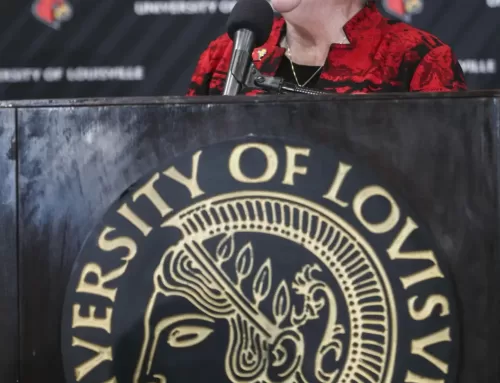This article is the second part of a three-part series. Read Part One and Part Three here.
By Simon Isham—
U of L receives incentives from the state for attracting and maintaining a diverse student, staff and faculty population. According to a review by the Kentucky Council on Postsecondary Education’s Committee on Equal Opportunities, the university received “automatic eligibility” to submit new academic program proposals this school year.
The Cardinal has, since September, spoken to an assortment of university personnel regarding the enrollment, retention and graduation of students of color here.
Some have heralded U of L as the most diverse institution of higher learning in the state of Kentucky. If this is true, exactly what kind of diversity does the university have? And what efforts will be needed on the part of the faculty, staff, students and administrators to sustain its growth?
Under Kentucky’s “Degree Program Approval; Equal Opportunity Goals” regulation, the CPE is required “to postpone the approval of new academic programs for those institutions who fail to meet equal opportunity goals established by the council.” U of L’s “automatic eligibility” categorization is the most favorable ranking possible, and is shared by Eastern Kentucky University and the University of Kentucky.
The review was sent from CPE Chief Diversity Officer Dr. Rana Johnson on Feb. 13, 2014 and initialed by U of L President James Ramsey and Provost Shirley Willihnganz on Feb. 18. Though the report was published this year, it measures data for the years 2009, 2010 and 2011.
All public universities in Kentucky are subject to the same annual review based on eight criteria for diversity growth. U of L, EKU, and UK showed progress on all of these objectives, while Kentucky State University, Morehead State University, Murray State University, Northern Kentucky University, and Western Kentucky University showed progress on only six.
The eight objectives to which U of L is accountable include the enrollment, retention and graduation of students as well as university hiring for faculty, staff and administrators. The plan was first implemented in 1982, and the objectives have been periodically updated since then. The current set of objectives has been in place from 2011 and will be until 2015.
The objectives for students focus on the enrollment and retention of black and Latino students, whereas the objectives for faculty and staff include American Indians, Alaskan Natives, Native Hawaiians and Pacific Islanders.
The report shows that the number of Hispanic and Latino students has continuously increased, as has their retention rate and degree production. Black undergraduates, in contrast, are shown to drop off significantly in enrollment numbers, while their first-to-second year retention rates remain high, and levels of degree production remained the same.
This is consistent with prior, preliminary data that the Cardinal requested from the Office of Academic Planning and Accountability. This data showed that 11.75 percent of students in the 2007 cohort identified as black, whereas only 9.975 percent of students in the 2013 cohort identified this way. Becky Patterson, executive director of Institutional Research, said that the decrease is statistically significant.
According to U of L’s Vice-Provost of Institutional Research, Effectiveness and Analytics Bob Goldstein, this likely has to do with a federally mandated definitional change in race and ethnicity data collection practices in higher education.
“Beginning in fall 2010, students were provided the opportunity to self-report two or more races to better represent an individual’s multicultural background. So, (the decrease in black enrollment) may be significant, but it will likely represent a classification change with regard to race or ethnicity more than any institutional change,” he said. “A better comparison may be to include all students that identify as African-American and students that report African-American as one of their reported races.”
One unexplained change in the CPE data may lie in the second-to-third year retention rate of black undergraduates, another of the eight objectives upon which public universities are judged. In 2009, the rate was 55.1 percent; in 2010, this fell to 54.8 percent. The fall 2011 data showed huge growth, with an 85.4 percent retention rate between the second and third years of college.
Here, too, the Cardinal’s preliminary data lined up; in general, the retention rate of black students is 79.4 percent — 1.5 percentage points higher than the average of the 2013 cohort.
The CPE’s sixth objective is the employment of diverse executive, administrative and managerial staff. Here, the university did not fare so favorably during the target years, though it did still meet all benchmarks. The number of black employees in “executive” roles declined from 13 in 2009 to 8 in 2011. The university did not have any employees in these roles who identified as American Indian, Alaskan Native, Hispanic, Latino, Native Hawaiian or Pacific Islander, for any of the target years.
Employment of black faculty remained fairly consistent. American Indian or Native Alaskan faculty doubled from one professor to two in 2010, and three Native Hawaiian or Pacific Islander faculty members were hired. Numbers of Hispanic and Latino faculty consistently increased. Black, Hispanic and Latino staff members also increased across the target period.
As a corollary to the CPE’s report, U of L drafted a diversity plan in 2011, in which it delineated its enrollment and retention goals for 2015. The university has already met many of these goals. Additionally, the Technology, Demographics and International Committee on the 21st Century Initiative, which includes Vice-Provost Taylor-Archer as a member, is responsible for identifying and refining diversity goals.
U of L Director of Admissions Jenny Sawyer believes that the CPE’s data — at least as it pertains to students — is fundamentally flawed, in that it only accounts for Kentucky resident students, and not those who come from other states.
“When (Admissions) looks at the data, we feel like we’ve had our largest incoming class ever of African-American first-time freshmen,” said Sawyer. “We’ve also seen a bump in the number of African-American transfer students.”
Many students begin their educational careers at U of L, then transfer to a community college like JCTC; many also transfer from community colleges to U of L. The ULtra program helps students take courses at JCTC that satisfy general education requirements and will be charged at a cheaper rate than those at U of L.
According to Sawyer, one fifth of U of L’s student body is comprised of transfer students, but one third of degrees are conferred to students who have transferred from another institution. A significant portion of these transfer students are students of color.
The Transfer Workout Advisory Group’s 2013 preliminary report showed a total of 244 “black, non-Hispanic only” students for the 2012-13 school year, the largest black transfer group in history. “Hispanic or Latino, regardless of race” transfer numbers remained high, but dipped from last year.
Sawyer said Taylor-Archer specifically asked her to focus on black transfer students for this upcoming year.




